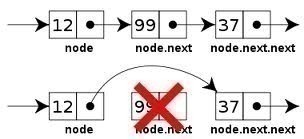A linked list is a way of storing information. A linked list consists of a series of nodes. Each node contains data, as well as a pointer to the next node in the series.
Runtime
O(n)Explanation
In order to access the node at index 2, we need to visit every node before it.Runtime
O(1)Explanation
We can insert a node in constant time by changing the pointer of the previous node to point to the new node.Runtime
O(n)Explanation
In order to find an element, we have to look at each node in the linked list.Runtime
O(1)Explanation
We need to change the pointer of a node to the node after the node we want to delete.We can make a functional linked list of Ints with only a Node class.
class Node {
var value: Int
var next: Node?
init(value: Int, next: Node? = nil) {
self.value = value
}
}But what if we want to be able to make our Linked List Node not limited just to Ints?
Generics are a powerful tool in Swift that lets us extend code to multiple different types. The symbol: 'T' indicates a generic type. Let's rewrite the code from above:
class Node<T> {
var value: T
var next: Node?
init(value: T, next: Node? = nil) {
self.value = value
}
}The 'T' in angle brackets indicates that the class will use generics. We can make the generic Node type conform to a protocol as well:
class Node<T: Equatable> {
var value: T
var next: Node?
init(value: T, next: Node? = nil) {
self.value = value
}
}Exercise: Create a series of nodes that matches the diagram below:
4 -> 9 -> 2 -> nil
Exercise: Create a series of nodes that matches the diagram below:
"d" -> "a" -> "c" -> "p" -> nil
Exercise: Create a series of nodes that matches the diagram below:
[1,2,3] -> [2] -> [6,8,2] -> [] -> nil
Exercise: Iterate through each linked list and print out every element.
We might want to build a little more structure on top of our Node class. Let's make a LinkedList class that will wrap the function
Exercise: Write a function that checks if two linked lists are the same
Sample Input 1:
3 -> 8 -> 4 -> 1 -> nil
1 -> 4 -> 8 -> 3 -> nil
Sample Output 1: false
Sample Input 2:
3 -> 8 -> 4 -> 1 -> nil
3 -> 8 -> 4 -> 1 -> nil
Sample Output 2: true
Exercise: Write a function that reverses a linked list
Sample Input 1:
3 -> 8 -> 4 -> 1 -> nil
Sample Output 1:
1 -> 4 -> 8 -> 3 -> nil
Linked List Implementation
class Node<T: Equatable>: CustomStringConvertible, Equatable {
public var value: T
public var next: Node?
var description: String {
guard let next = next else { return "\(value) -> nil" }
return "\(value) -> \(next)"
}
static func ==(lhs: Node, rhs: Node) -> Bool {
return
lhs.value == rhs.value &&
lhs.next == rhs.next
}
init(value: T) {
self.value = value
}
}
class LinkedList<T: Equatable>: CustomStringConvertible {
private var head: Node<T>?
private var tail: Node<T>?
var description: String {
guard let head = head else { return "empty list" }
return "\(head)"
}
public var first: Node<T>? {
return head
}
public var last: Node<T>? {
return tail
}
public var isEmpty: Bool {
return head == nil
}
public func append(_ value: T) {
let newNode = Node(value: value)
if let lastNode = tail {
lastNode.next = newNode
} else {
head = newNode
}
tail = newNode
}
public func removeLast() -> Node<T>? {
guard !isEmpty else { return nil }
var removedNode: Node<T>?
if head == tail {
removedNode = head
head = nil
tail = nil
}
var currentNode = head
while currentNode != nil {
if currentNode?.next == tail {
removedNode = currentNode?.next
currentNode?.next = nil
tail = currentNode
}
currentNode = currentNode?.next
}
return removedNode
}
}A doubly linked list is very similar to a singly linked list. The only distinction is that each Node has both a next Node as well as a previous Node.
The main advantage to using a doubly linked list is that we can iterate through in either direction.
We'll need to rewrite our Node to include a previous Node.
class Node<T: Equatable> {
var value: T
var next: Node?
var previous: Node?
init(value: T, next: Node? = nil) {
self.value = value
}
}Exercise: Reverse a doubly linked list
Sample Input 1:
[3, 8, 4, 1]
Sample Output 1:
[1, 4, 8, 3]

